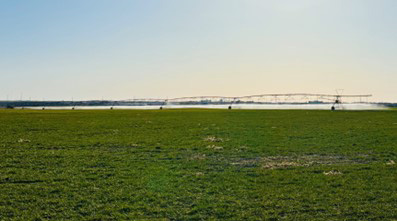Giving your irrigation system a thorough check-up and tune-up this spring can lead to more effective water application and potentially, to fewer breakdowns or problems during the heart of the irrigation season. Even if irrigation has started in places like southwestern Kansas, it’s important to go through this checklist to potentially save energy and costs while irrigating to the best of the system’s abilities. The above-average seasonal temperatures might have made it where some have jumped into irrigation already, though the nights are still cold.
Here are some areas to check before irrigation starts or with the first irrigation occurs. These areas include the pump and pivot itself, but there may be additional areas to consider as this is not an exhaustive list. Some of this checklist might have been done in the fall.
- Clean pipes and structure of animal nests and check for any damage on the wires.
- Check all panel or pump wires for rodent damage.
- Change all lubricants, associated filters, and fluids if not done in the fall: engine, fuel, cooling system.
- Refill the drip oil reservoir and allow oil to drain into the drip line based on pump column length.
- Grease drive shafts on the pump and motor.
- Check gearboxes for each pivot tower.
- Check spark plugs on gas, propane, or natural gas motors.
- Ensure that the right-angle gear head is free moving and clean and lubricate non-reverse pins.
- Blow out any in line filters of debris and check for damage
- Flush system thoroughly with drains removed/open to prevent plugging nozzles and pressure regulators.
- Close any drains/ valves that were opened.
- Most newer pivots have automatic frost drains that do not need maintenance, but it’s a water loss orifice that shouldn’t be overlooked.
- Tighten all pressure valves back into operation if loosened or removed for winter months
- Run the motor at the normal operating speed for 45 minutes and walk along the system looking for faulty sprinklers. Look for plugging, broken sprinklers, partially opened valves (if present), unusual distribution/movement, and leaks. If no faulty sprinklers, then any hoses and sprinklers that might have fallen off in the winter.
- Check the pressure at the pivot point and at the end of the system, particularly at the highest point of the field. Compare this to the design pressure indicated in the pivot chart and adjust accordingly.
- Nozzle wear depends on the quality of the water and the system operating pressure. As a rule of thumb, sprinkler replacement should be considered after approximately 10,000-12,000 hours of operation.
- Be sure to replace malfunctioning nozzles with ones listed on the computer printout you received from the manufacturer (i.e. pivot chart).
- Visually inspecting the sprinkler in operation before the irrigation season starts can help identify whether water application is uniform and adequate and whether repairs are needed.
- If in an area with water quality concerns, grab some water samples for water quality testing to anticipate necessary mitigation.
- Check the chemigation pump and safety equipment operation.
- Check hoses and replace them if cracking is noticeable.
- Check for correct air pressure and extreme wear and tear in each pivot tire
Performing a preseason checkup of your irrigation equipment this spring should be part of your regular maintenance schedule. Component wear happens, resulting in less uniform water application, increased energy use, and untimely breakdowns during your irrigation season. Identify and replace worn components now to have your system ready when you need it.

Figure 1. Picture of a pivot running at the SW research center in Garden City. Photo by Logan Simon, K-State Research and Extension.
Tina Sullivan, Northeast Area Agronomist
tsullivan@ksu.edu
Jonathan Aguilar, Water Resources Engineer
jaguilar@ksu.edu
Tags: irrigation equipment